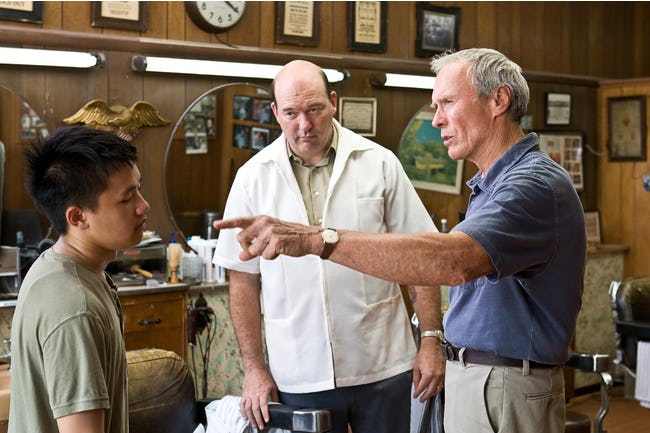'Gran Torino' dir. Clint Eastwood - analysis of 'sacrifice' sequence
Below is an example of how someone wrote about 'Gran Torino'. It is an old essay, it answers a specific question, it does not use the PEAR paragraph and it is also very long - you only have forty-five minutes - nonetheless, it may be useful to have a look at it, to get some ideas.
Remember that, because this essay appears on the internet, copying it is plagiarism.
.
Choose a scene or sequence from a film which is particularly dramatic. Describe what happens in the scene or sequence, explaining how the film makers effectively use techniques to create drama.
A
film in which there is a particularly dramatic sequence is ‘Gran Torino’,
directed by and starring Clint Eastwood. The story is set in modern day Detroit,
where the central character, Walt Kowalski, a retired car plant worker and
Korean War veteran, struggles to come to terms with the changes in his
community. In particular, the plot revolves around his unlikely friendship with
Thao, a teenage boy from a Hmong immigrant family.
As
the plot progresses, Walt realises that Thao’s chances of success are being
hampered because he is under pressure to join a troublesome gang of Hmong
youths. For this reason, in one of the final sequences of the film, Walt goes
to confront the gang and sacrifices himself so that Thao’s family can be free
of the gang.
In
this climactic sequence, the director, Eastwood, uses a dramatic setting. Walt
goes at nightfall to challenge the Hmong gang. The urban street is virtually
empty and all that can be heard is the sound of crickets, a dog barking and
people within buildings. Very soon, however, a blind moves in the block of
flats and Smokie, a gang member, comes out of the door. Here, Eastwood wishes
to show that Walt is seeking a final confrontation, or ‘showdown’, because,
when he previously visited this street, he violently assaulted Smokie.
Eastwood
also uses characterisation here to increase the tension of the sequence. As he
has done throughout the film, Walt uses a very gruff voice and uses aggressive
and provocative racist language to engage with the gang. He shouts, “Any swamp
rats in there?” and we see a long shot of the front of the building from behind
Walt – virtually from his point of view. This characterisation is quite in
keeping with the way Walt has been portrayed throughout the movie. It suggests
further violence to come. Another characteristic Walt has is that he uses his
hand, in imitation of a gun, to threaten people. This detail is used here and
we see a low angle medium shot of Walt pointing his finger at the gang, calling
them ‘miniature cowboys’.
Next,
as the situation escalates and more onlookers are seen coming to their windows,
Eastwood uses music to heighten tension. As in previous sequences, when Walt was
on the verge of using a gun to resolve an issue, the sound of military type
drums is heard. This also recalls Walt’s previous experience of armed conflict
in Korea. This effect is further developed as orchestral strings play to build
anticipation in the audience. In using this music, Eastwood certainly leads the
audience to believe that a shootout is going to occur.
Furthermore,
Eastwood uses a clever combination of camera shots, camera angles and editing
as the sequence is resolved. Walt has a cigarette and then makes a move for his
inside pocket. The camera cuts ( shot/reverse shot ) between Walt and the
increasingly agitated, gun-toting gang members on the porch of their apartment
block. We see Walt’s hand from a low angle as he lifts it to his jacket, then
Walt’s point-of-view shot of the porch. The camera cuts back to Walt, who is
muttering a prayer and there is a close up of his hand going into his jacket.
There is a further reverse shot, before we see Walt’s hand being drawn quickly
from his jacket – as if he is drawing a gun. The director has cut quickly
between shots here as the tension rises to breaking point.
We
then see Walt’s point-of view shot of the gang firing wildly at him. Here,
Eastwood has drawn the audience into the moment. The music stops and only
gunshots are heard. Then we see, in medium shot, the front of Walt’s torso
taking the shots, followed by the bullets exiting from his back. Then he falls
to the ground in slow motion.
This
is exactly what Walt had planned. He was old, had cancer and, after preparing
for his death, had provoked the gang into shooting him. He had no gun and, as
he makes his final sigh, we see in close-up that his hand only contains his
military cigarette lighter. This cleverly reminds the audience of his violent
past and that he has allowed himself to be shot to help his friends. His
killers have been witnessed shooting an unarmed man, which will allow them to
be convicted and locked up. This final theme of sacrifice is underlined when
the camera spirals upwards from Walt’s body. The mournful ‘Gran Torino’ theme
is played on piano and we see that he is lying in a symbolic ‘crucifix’
position. From this, if we follow Christian symbolism, the viewer understands
that he has died so that his friends might live.
In
conclusion, it is clear that Clint Eastwood used a number of the techniques of
film-making to create a dramatic sequence which was crucial to the outcome of
the film. The character of Walt Kowalski died in a manner which came as a
considerable surprise to the viewer and this element of the plot was enhanced
by thoughtful use of setting, characterisation, music, camera work and cutting.

